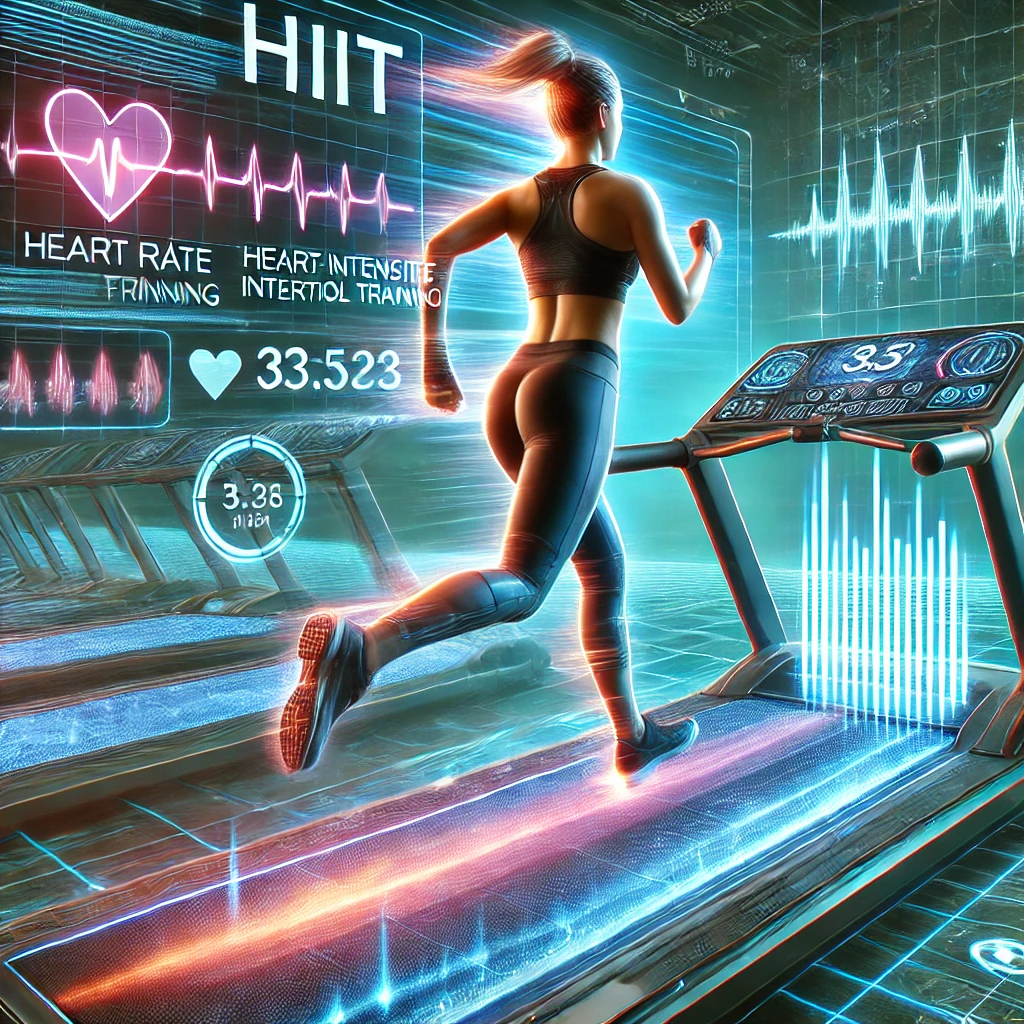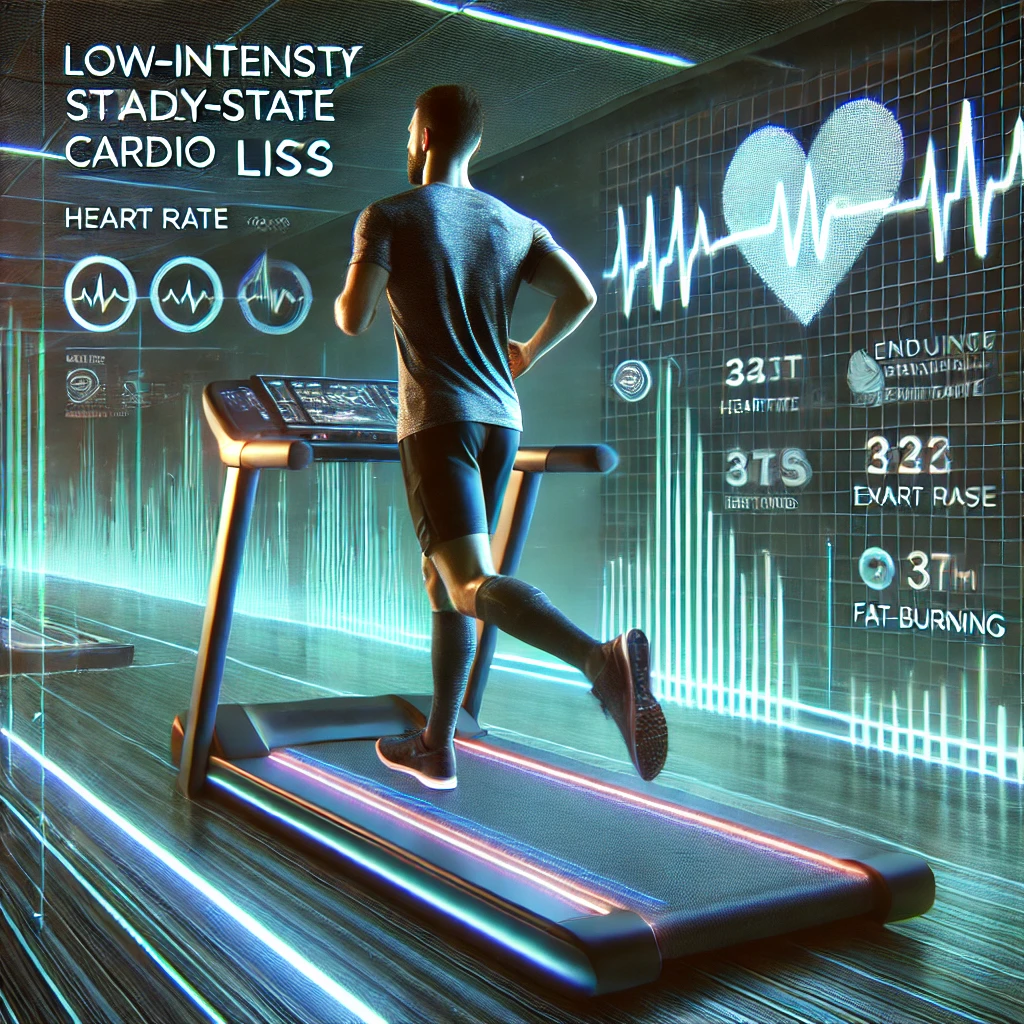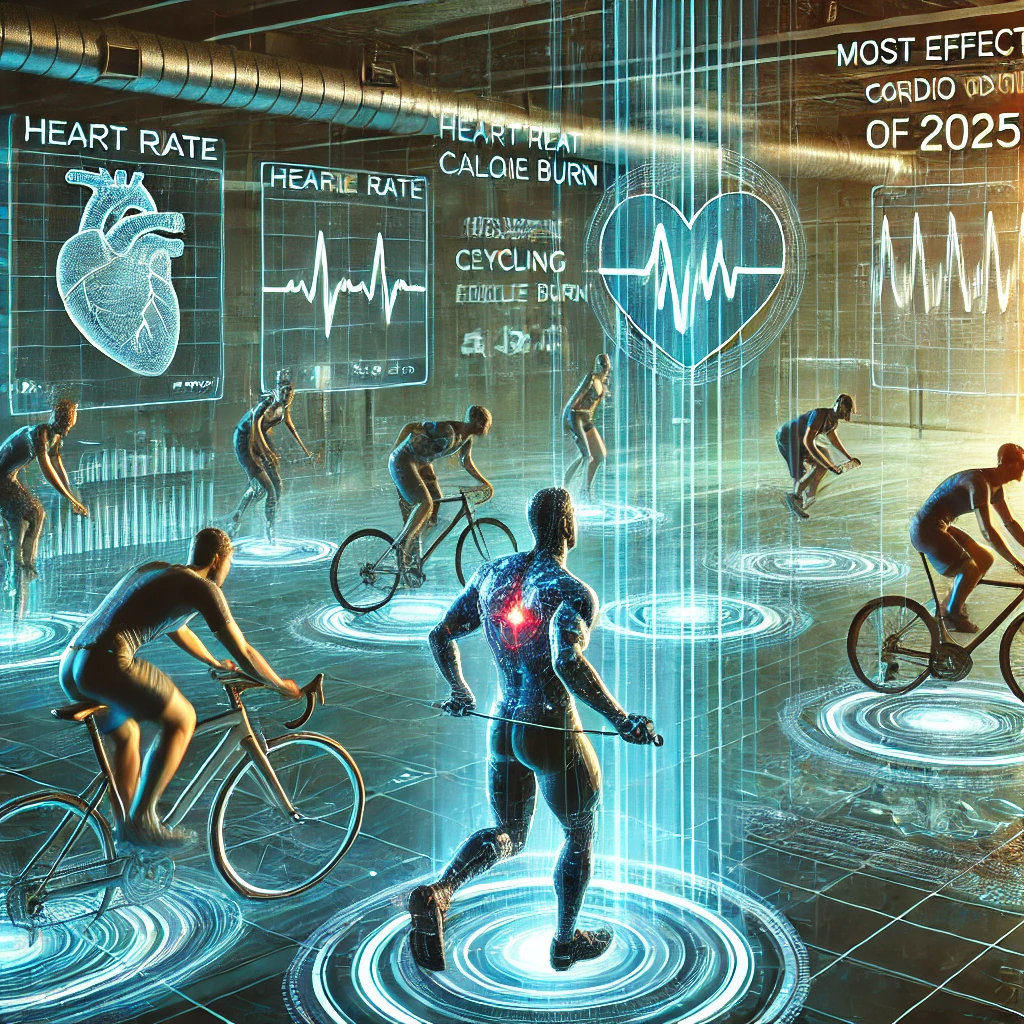Cardio workouts have long been the foundation of fitness, playing a crucial role in fat loss, endurance building, and overall cardiovascular health. However, as fitness science evolves, so do the methods used to maximize efficiency, calorie burn, and stamina. In 2025, cutting-edge research and advancements in training techniques have revolutionized the way we approach cardio workouts. Whether you’re an athlete looking to push your limits or someone trying to shed excess fat, understanding the most effective cardio exercises will help you reach your fitness goals faster and more efficiently.
This guide will explore the best cardio workouts of 2025, their benefits, and how to incorporate them into your routine for optimal fat-burning and endurance development.
1. The Science Behind Cardio: How It Works

Before diving into the most effective workouts, it’s essential to understand how cardio affects the body.
1.1. What Is Cardiovascular Exercise?
Cardio, or aerobic exercise, involves sustained physical activity that increases heart rate, oxygen consumption, and blood circulation. These workouts improve the efficiency of the cardiovascular system, making it easier for the body to deliver oxygen and nutrients to muscles. Cardio training is essential for maintaining heart health, reducing the risk of chronic diseases, and improving lung function.
Over the years, research has shown that different types of cardio workouts yield varying benefits. Some are more effective for fat loss, while others are better suited for building endurance and improving cardiovascular efficiency. Understanding how cardio works will help individuals tailor their workouts to align with their specific goals, whether it’s weight loss, athletic performance, or general health improvement.
1.2. How Cardio Burns Fat and Improves Endurance
One of the primary reasons people engage in cardio workouts is for fat burning and endurance development. Here’s how cardio achieves these benefits:
- Fat Oxidation: During prolonged cardio sessions, the body initially relies on glycogen (stored carbohydrates) for energy. However, as the workout continues, the body shifts to burning fat for fuel. This process, known as fat oxidation, is one of the key mechanisms behind weight loss and fat reduction.
- Heart and Lung Efficiency: Regular cardio strengthens the heart and lungs, making them more efficient at delivering oxygen-rich blood to the muscles. This enhances endurance and reduces fatigue during exercise.
- Metabolic Boost: High-intensity cardio sessions trigger the afterburn effect (EPOC – Excess Post-Exercise Oxygen Consumption), meaning your body continues burning calories even after the workout ends. This metabolic boost can lead to greater fat loss over time.
- Mitochondrial Growth: Endurance training stimulates the production of more mitochondria, the energy-producing powerhouses of cells. More mitochondria mean that muscles can work longer before fatigue sets in, significantly improving stamina and athletic performance.
- Hormonal Benefits: Cardio exercises stimulate the release of endorphins, also known as the “feel-good hormones,” which reduce stress and enhance mood. Additionally, cardio helps regulate insulin levels, preventing blood sugar spikes and crashes.
1.3. The Different Types of Cardio Workouts
Not all cardio workouts are the same. Depending on the intensity, duration, and structure, cardio workouts can be categorized into different types, each offering unique benefits:
- High-Intensity Interval Training (HIIT): Short bursts of intense exercise followed by rest or low-intensity recovery periods. Best for rapid fat loss and metabolic boosts.
- Low-Intensity Steady-State Cardio (LISS): Sustained, moderate-intensity activity, such as walking or cycling. Ideal for endurance building and fat oxidation.
- Hybrid Cardio Training: A combination of HIIT and LISS to maximize fat loss while maintaining endurance.
- Plyometric Cardio Workouts: Jump-based exercises that enhance explosive power and coordination.
- Functional Cardio: Includes movement patterns that mimic real-life activities, such as kettlebell swings and sled pushes, improving overall athleticism.
Each type of cardio has its place in a well-rounded fitness routine. The key is to determine which type aligns best with your goals and preferences.
1.4. How to Choose the Right Cardio Workout
The most effective cardio workout is one that matches your fitness level, goals, and lifestyle. Here’s a simple guide to choosing the right cardio method:
- If your goal is fat loss: HIIT and Hybrid Cardio are the best options due to their calorie-burning efficiency.
- If you want to improve endurance: LISS and long-distance running/swimming are excellent choices.
- If you need a joint-friendly workout: Swimming, rowing, and elliptical training are ideal.
- If you prefer fast workouts: HIIT allows for maximum calorie burn in the shortest time possible.
- If you’re looking for functional fitness: Plyometric cardio and battle ropes provide agility and coordination benefits.
By incorporating the right cardio type into your routine, you can maximize results, prevent overtraining, and maintain long-term fitness success.
2. High-Intensity Interval Training (HIIT): The Fat-Burning Powerhouse

2.1. What is HIIT?
High-Intensity Interval Training (HIIT) is a workout method that alternates between short bursts of intense exercise and low-intensity recovery periods. It has been proven to burn more fat in less time compared to steady-state cardio.
2.2. The Physiological Impact of HIIT
HIIT workouts are highly effective because they:
- Create an oxygen deficit, forcing the body to consume more oxygen post-workout, increasing calorie expenditure.
- Increase anaerobic and aerobic capacity, helping athletes improve speed and endurance simultaneously.
- Stimulate fast-twitch muscle fibers, which are responsible for explosive power and acceleration.
- Trigger the release of growth hormones, which promote fat loss while preserving muscle mass.
- Improve insulin sensitivity, reducing the risk of type 2 diabetes and improving metabolic function.
2.3. Why HIIT is One of the Best Cardio Workouts in 2025
- Maximizes Fat Burn: Studies show that HIIT workouts can burn up to 30% more calories than traditional cardio.
- Shorter Workout Duration: Sessions last between 15-30 minutes, making it time-efficient.
- Increases VO2 Max: Boosts the body’s ability to use oxygen effectively, improving stamina.
- Reduces Risk of Cardiovascular Disease: HIIT lowers blood pressure and improves heart health.
- Versatility: HIIT can be performed using bodyweight exercises, weights, machines, or sprinting.
2.4. Sample HIIT Workout Routine
Total Workout Time: 20-30 minutes
- Warm-up: 5 minutes of dynamic stretching and light jogging.
- Workout:
- Sprint (30 seconds)
- Walk (30 seconds)
- Jump Squats (30 seconds)
- Rest (30 seconds)
- Burpees (30 seconds)
- Mountain Climbers (30 seconds)
- Repeat for 4-6 rounds
- Cooldown: 5 minutes of light jogging and static stretching.
2.5. Common HIIT Mistakes to Avoid
- Skipping the warm-up: HIIT is intense, and jumping in too fast increases the risk of injury.
- Doing HIIT too frequently: More than 3-4 sessions per week can lead to burnout and muscle fatigue.
- Not balancing intensity and recovery: Rest periods should be long enough to recover, but not too long to lose momentum.
- Poor form: Performing exercises incorrectly at high intensity can cause injuries.
3. Low-Intensity Steady-State Cardio (LISS): The Endurance Booster

3.1. What is LISS?
Low-Intensity Steady-State (LISS) cardio involves performing aerobic activity at a consistent, moderate pace for an extended period. It is ideal for those looking to increase endurance while minimizing stress on the joints.
3.2. The Science Behind LISS
LISS works primarily by utilizing the aerobic energy system, which allows the body to sustain activity for long durations. Unlike HIIT, which relies on short bursts of intense effort, LISS maintains a steady, moderate heart rate, optimizing fat oxidation and cardiovascular efficiency.
Additionally, LISS helps the body develop capillary density, meaning more oxygen can be delivered to the muscles over time. This is crucial for endurance athletes and those who engage in long-duration sports such as marathon running or cycling.
3.3. Benefits of LISS
- Enhances Fat Burning: Works at an optimal fat-burning heart rate (50-65% of max heart rate).
- Improves Cardiovascular Health: Strengthens the heart and lowers resting heart rate.
- Aids in Recovery: Can be used as an active recovery workout after intense training sessions.
- Lower Injury Risk: Due to its lower impact, it reduces the risk of stress-related injuries.
- Increases Oxygen Utilization: Over time, LISS enhances how efficiently muscles use oxygen, improving endurance capacity.
3.4. Best LISS Exercises
- Brisk Walking: 4.0-4.5 mph on a treadmill.
- Cycling: Low resistance cycling for endurance.
- Swimming: Steady-paced laps for full-body endurance.
- Elliptical Training: Consistent moderate intensity for sustained calorie burn.
- Rowing: Provides a total-body endurance workout with low impact on the joints.
3.5. Sample LISS Workout Routine
Total Workout Time: 45-75 minutes
- Warm-up: 5-10 minutes of slow walking or dynamic stretching.
- Workout:
- 45-60 minutes of steady-state cardio at a moderate intensity.
- Cooldown: 10 minutes of light stretching and deep breathing.
3.6. Common Mistakes to Avoid with LISS
- Going Too Slow: LISS should be moderate intensity, not a casual stroll.
- Overdoing It: Doing LISS every day without variation can limit progress.
- Ignoring Strength Training: LISS should be complemented with resistance training for balanced fitness.
- Not Monitoring Heart Rate: To maximize fat burning, ensure your heart rate stays within the 50-65% range of your maximum heart rate.
4. The Rise of Hybrid Cardio Training

4.1. What is Hybrid Cardio?
Hybrid cardio is a revolutionary training approach that combines the intensity of High-Intensity Interval Training (HIIT) with the sustained endurance of Low-Intensity Steady-State (LISS) cardio. Unlike traditional cardio methods, hybrid cardio allows individuals to reap the benefits of both training styles, making it one of the most effective and efficient approaches for fat loss, endurance, and cardiovascular health in 2025.
Why is Hybrid Cardio Different?
Traditional cardio approaches have often forced fitness enthusiasts to choose between high-intensity, short-duration workouts (HIIT) and low-intensity, long-duration workouts (LISS). Hybrid cardio eliminates this compromise by incorporating both elements into a single session, allowing the body to experience the caloric burn and metabolic boost of HIIT, while also benefiting from the steady endurance-building nature of LISS.
Key Benefits of Hybrid Cardio:
- Maximized Fat Burn: HIIT creates an oxygen deficit that forces the body to burn calories long after the workout ends, while LISS helps sustain fat oxidation.
- Balanced Intensity: Prevents excessive fatigue and muscle breakdown by alternating between intense and moderate activity.
- Increased Athletic Performance: Develops both explosive power and endurance stamina, essential for competitive sports and overall fitness.
- Time-Efficient Workouts: A single hybrid cardio session can achieve the benefits of both HIIT and LISS in less time, making it ideal for busy individuals.
- Sustainable Long-Term Training: Unlike purely high-intensity workouts, hybrid cardio is easier on the joints, reducing injury risk and promoting long-term cardiovascular health.
By incorporating intense bursts of effort followed by sustained endurance phases, hybrid cardio provides a well-rounded, scientifically-backed method to improve overall fitness. Whether you’re an athlete looking to enhance performance, or someone aiming to burn fat efficiently, hybrid cardio delivers results faster and with greater sustainability than conventional training methods.
4.2. Why Hybrid Cardio is a Game-Changer in 2025
Hybrid cardio is gaining widespread popularity in 2025 due to its dual benefits of high-intensity fat-burning and sustained endurance building. Unlike conventional training methods that force individuals to choose between short, intense bursts of activity (HIIT) and prolonged steady-state workouts (LISS), hybrid cardio merges the two seamlessly into a highly efficient training style.
- Time Efficiency: Busy schedules make long cardio sessions difficult. Hybrid cardio achieves maximum calorie burn in a shorter period, making it ideal for modern fitness enthusiasts.
- Sustained Fat Burn: HIIT increases metabolic rate, while LISS extends fat-burning effects, creating an all-day calorie-burning effect.
- Joint-Friendly Workouts: Unlike pure HIIT, hybrid cardio incorporates moderate phases, reducing stress on joints and lowering injury risks.
- Improved Aerobic & Anaerobic Performance: This training optimizes heart rate zones, enhancing both endurance and explosive strength.
4.3. Benefits of Hybrid Cardio Training
The benefits of hybrid cardio extend beyond simple fat loss. It provides well-rounded physical conditioning, making it beneficial for athletes, general fitness enthusiasts, and even older adults looking for a sustainable exercise model.
- Fat Loss Acceleration: Hybrid cardio keeps metabolism elevated longer than traditional cardio, optimizing weight loss.
- Enhanced Muscle Retention: Unlike excessive LISS workouts that may break down muscle, hybrid cardio preserves lean muscle mass.
- Increased Cardiovascular Health: By alternating intensities, the heart adapts better to different stress levels, strengthening overall cardiovascular function.
- Prevents Burnout: The combination of short bursts and moderate movement prevents extreme exhaustion, making workouts more sustainable.
4.4. Who Should Use Hybrid Cardio?
Hybrid cardio is an adaptable approach that can benefit various fitness levels and goals:
- Athletes: Enhances agility, endurance, and explosive speed.
- Weight Loss Seekers: Ideal for individuals aiming for maximum calorie burn in minimal time.
- Busy Professionals: Provides a time-efficient workout without compromising effectiveness.
- Older Adults: Gentle enough for joint health while promoting cardiovascular endurance.
4.5. Best Hybrid Cardio Exercises
To maximize hybrid cardio, exercise selection is key. Some of the best hybrid cardio exercises include:
- Treadmill Intervals: Sprint for 30 seconds, followed by 2 minutes of brisk walking.
- Rowing Machine: Perform explosive strokes for 40 seconds, then slow down for 1 minute.
- Jump Rope Circuit: Intense jump rope (30 sec) → bodyweight squats (30 sec) → light jogging (60 sec) → repeat.
- Stair Climbing Routine: Sprint upstairs, then walk down slowly for active recovery.
4.6. Sample Hybrid Cardio Routine
A 40-minute hybrid cardio session might include:
- Warm-up: 5 minutes of jogging.
- Workout:
- 5 minutes moderate cycling.
- 30 seconds all-out sprinting.
- 5 minutes steady running.
- 30 seconds high-intensity jump rope.
- Repeat 4-5 rounds.
- Cooldown: 5-10 minutes of slow jogging and stretching.
4.7. Hybrid Cardio and Weight Loss
- Burns More Calories in Less Time: Combining the explosive intensity of HIIT with the endurance-building aspects of LISS ensures sustained calorie burn.
- Maintains Muscle Mass: Unlike traditional steady-state cardio, hybrid training prevents excessive muscle breakdown, preserving lean body mass while still optimizing fat loss.
- Boosts Metabolism: The constant shift between intensities encourages sustained calorie burning throughout the day, even when at rest.
- Improves Insulin Sensitivity: Enhances the body’s ability to regulate blood sugar, reducing the risk of insulin resistance and weight gain.
4.8. Hybrid Cardio for Endurance Athletes
- Enhances Aerobic and Anaerobic Performance: Hybrid training targets both aerobic (oxygen-dependent) and anaerobic (explosive) systems, improving overall stamina and power.
- Optimizes Heart Rate Zones for Maximum Efficiency: Athletes can train in multiple heart rate zones, developing a stronger and more adaptable cardiovascular system.
- Increases VO2 Max: The body’s ability to utilize oxygen efficiently is enhanced, translating to better performance in long-duration activities such as marathons, cycling, and triathlons.
- Improves Recovery Time: Since hybrid training incorporates lower-intensity intervals, it allows the body to recover more efficiently while still maintaining movement.
- Reduces Risk of Overuse Injuries: Alternating between high- and low-intensity exercises prevents excessive stress on the joints, reducing the likelihood of injuries common in endurance sports.
4.9. Common Mistakes to Avoid in Hybrid Cardio
- Overtraining: While hybrid cardio is highly effective, excessive sessions without proper recovery can lead to burnout and decreased performance.
- Improper Intensity Balance: Balancing high-intensity sprints with sufficient recovery periods ensures maximum efficiency. Too much intensity without recovery can lead to exhaustion, while too much recovery may diminish benefits.
- Neglecting Strength Training: Hybrid cardio should complement strength training, not replace it. Resistance exercises are crucial for maintaining muscle integrity and preventing imbalances.
- Ignoring Nutrition: Fueling the body correctly before and after workouts enhances endurance, optimizes recovery, and ensures long-term performance gains.
- Not Monitoring Progress: Tracking performance metrics such as heart rate, VO2 max, and endurance levels helps adjust training programs for optimal results.
Conclusion
2025 has introduced cutting-edge cardio strategies designed to maximize fat burn, endurance, and cardiovascular health. The best cardio workouts include HIIT for fast fat loss, LISS for endurance building, and Hybrid Cardio for a balanced approach.



